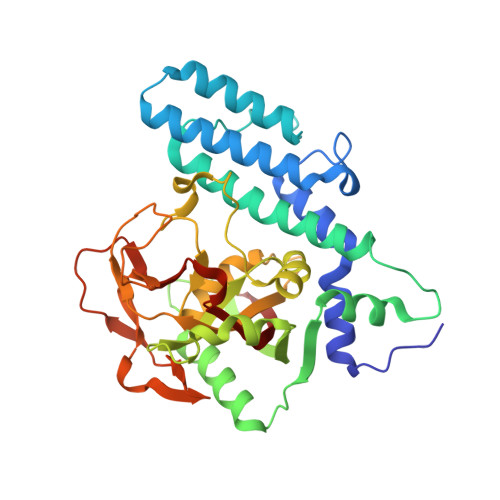Employing a Highly Potent Fluorescence Probe to Discover a PARP-1/2 Binder and the Complex Structures Analysis.
Wang, X., Wang, C., Li, J., Zhou, J., Xu, B.(2025) ChemMedChem : e202500168-e202500168
- PubMed: 40204633
- DOI: https://doi.org/10.1002/cmdc.202500168
- Primary Citation of Related Structures:
8JNY, 8JNZ - PubMed Abstract:
Poly (ADP-ribose) polymerases-1/2(PARP-1/2) has been identified as important anti-tumor drug targets, and the development of PARP-1/2 inhibitors featuring novel structures is still a promising strategy for cancer treatments. In this work, a highly potent PARP-1/2 probe with a quinazolinone scaffold was designed and synthesized, showing dissociation constants (Kd) of 2.07 nM and 1.6 nM towards catPARP-1 and catPARP-2SE. By employing this probe to screen an in-house compound library, compound A bearing a pyrazolo[1,5-a]pyrimidine-3-carboxamide scaffold was disclosed as a structurally novel PARP-1/2 binder, which had dissociation constants of 5.6 μM and 7.9 μM for catPARP-1 and catPARP-2SE in the Isothermal Titration Calorimetry (ITC) assay. Moreover, the crystal structures of compound A in complex with PARP-1 and PARP-2 catalytic domains were solved to reveal the binding modes of this compound, and these two complex structures were analyzed with IGMH method at GFN2-xTB and B3LYP levels. Interestingly, this compound presented significant differences in binding modes within PARP-1 and PARP-2. These results could provide a structural basis for the discovery of novel PARP-1 or PARP-2 selective inhibitors by taking compound A as a template structure.
- Institute of Material Medical: Chinese Academy of Medical Sciences & Peking Union Medical College Institute of Materia Medica, synthetic medicinal chemistry, CHINA.
Organizational Affiliation:


















